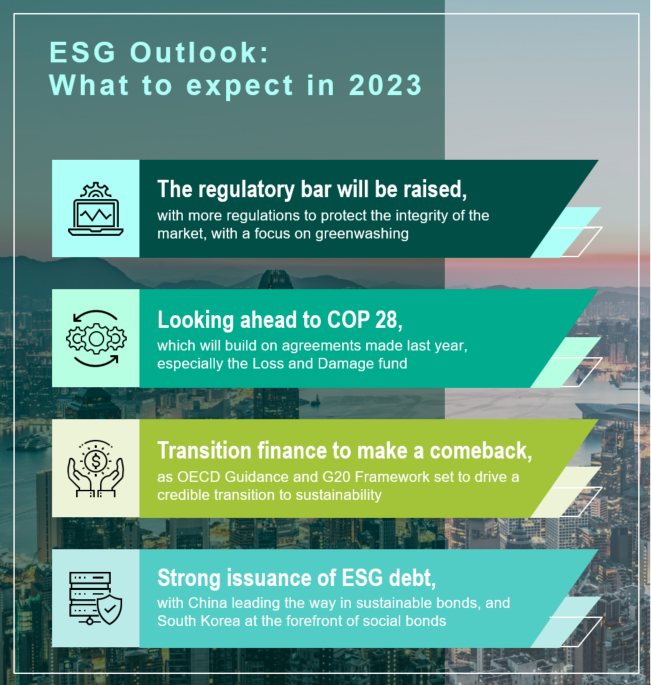After a year of challenges to progress on the sustainable transition, the Asia Pacific region is on track to see renewed progress in environmental, social and governance (ESG) matters.
Speaking at the recent BNP Paribas’ ESG APAC Outlook 2023, experts discussed how significant developments in regulation, multilateral cooperation, transition finance and the growth of green bonds will shape the agenda in 2023.
Raising the regulatory bar
The regulatory environment plays a critical role for the development of sustainable finance. The international framework around sustainable finance activities is still evolving to meet the diverse needs of all market participants, however, several major regulatory events will likely take place in 2023.
“There will be more regulations to protect the integrity of processes in sustainable finance, ensuring the healthy development of the market, on both the buy side and sell side,” says Chaoni Huang, Head of Sustainable Capital Markets APAC, BNP Paribas.
Greenwashing is a focal point for regulators, and new rules will be increasingly prescriptive about what counts as “sustainable” and how that can be assessed. In Asia Pacific, Australia has recently set out a definition for greenwashing, together with obligations to prohibit misleading and deceptive statements. Other jurisdictions in the region will add rules to safeguard their ESG markets.
Another area where we can expect regulatory progress is in the harmonisation of taxonomies, as more uniform standards will provide financial institutions with clearer comparisons on local criteria to evaluate activities and assets that can be considered green.
Looking ahead to COP28
In recent years, the annual Congress of the Parties (COP) summits have become the key venue for multilateral discussions on climate change. The upcoming COP28 event in the United Arab Emirates will build on agreements made last year, that are particularly relevant for Asia’s emerging markets.
The headline announcement from COP27 was the breakthrough agreement to launch the Loss and Damage Fund that will help emerging markets deal with the economic impact of environmental catastrophes.
“One of the key elements to come out of COP28 will be details on the Loss and Damage Fund,” says Trevor Allen, Head of Sustainability Research, BNP Paribas. “What will be the size of the fund? What is going to be the mechanism to get money to countries when they actually need it?”
Other subjects for discussion will be the carbon offset agreements that allow countries and companies to pay counterparts in places with lower pollution to offset their emissions – a system that will help emerging markets to fund their own transition and mitigation journeys.
Transition finance to make a comeback
One of the key ESG finance trends to look out for in 2023 will be transition finance, as the newly-published OECD Guidance and G20 Framework look set to drive a credible transition from high-carbon activities to more sustainable alternatives.
The vast majority of global economic activity does not meet pure green standards. The G20 Framework and OECD Guidance will help address financing obstacles by broadening criteria so that high-impact sectors can obtain funding for their transition projects.
There is also a growing realisation that the energy transition can have negative social consequences – for example, unemployment as jobs related to fossil fuel usage become scarce.
“Transition finance must therefore put the social implications front and centre,” says Huang. “It requires roadmaps and performance monitoring to ensure that transition is not just a one-off project, but a dynamic process that will be felt across large sections of society.”
What is transition finance?
Transition finance is an investment approach that supports the shift towards a net zero economy. This not only includes funding “pure green” activities, but also sectors that emit large amounts of greenhouse gases.
Transition finance is guided by the G20 Sustainable Finance Roadmap, which was endorsed by G20 leaders at the 2021 Rome Summit. It calls for transition finance issue to be incorporated into sustainable finance methodologies to avoid greenwashing. The guiding pillars include: identifying transitional activities, reporting, developing finance instruments, designing policies, and measuring impact.
Strong issuance of ESG debt
The final part of the APAC outlook covered the supply of ESG bonds. In 2023, BNP Paribas expects green bond issuance to slightly exceed 2021 levels, growing to around US$600 billion. In Asia, China looks set to continue to be the largest regional issuer due to supportive policies and the recent alignment towards international standards – such as the China-EU Common Ground Taxonomy.
“From an investor’s perspective, it is heartening that despite the negative macro environment the sustainable debt supply is able to remain resilient,” says Xuan Sheng Ou Yang, Green Bonds and ESG Analyst, BNP Paribas Asset Management.
The recovery in issuance is making Asia into a rising powerhouse in sustainable bonds. When it comes to green bond issuance and sustainability-linked bonds, China is in the lead. South Korea is at the forefront of both regional social bond issuance and sustainability bond issuance.
The capex that these instruments fund are key to transition to a more sustainable world. China, in particular, is the world leader in global energy transition investments, demonstrating the best balance between investing into clean energy projects – such as renewable energy and energy storage – and clean energy demand – electrified transport and sustainable materials. The effect of these ESG investments will be felt in Asia and beyond, as the world’s most dynamic region pivots to sustainable development.

